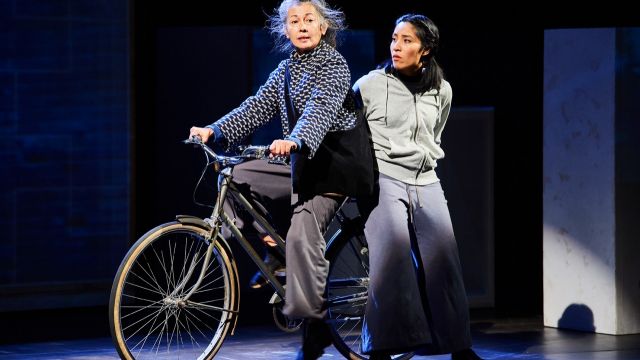A Ghost in My Suitcase
Celeste (Alice Keohavong), a French-Chinese Australian girl, travels to China to scatter the ashes of her mother at the mother’s birthplace. In China, Celeste stays with her grandmother, Por Por (Amanda Ma) and Por Por’s adopted daughter Ting Ting (Yilin Kong), a girl Celeste’s age and grumpy at this intruder. But Por Por is a ghost hunter, a kind of exorcist, and Celeste will overcome her Aussie scepticism and her fears and discover that she is a ghost hunter too.
The staging, by co-directors Ching Ching Ho and Matt Edgerton, the set design by Zoe Atkinson, and the lighting design by Matthew Marshall are all absolutely outstanding. Working with media artist Sohan Ariel Hayes, they use brilliant projections and simple multi-purpose structures to create detailed milieus both interior and exterior.
The stand-outs are a boat trip down a canal in Shanghai, buildings and statuary either side, water rippling under the boat, and the gloomy interior of a haunted mansion. In the latter, scary use is made of a floating, flailing sheet and a bed that comes to life. The puppetry consultant is Michael Barlow. These effects are flawless, smoothly executed and often breath-taking.
As storytelling and stage drama, however, A Ghost in My Suitcase is disappointing. Without having read Gabrielle Wang’s award-winning and highly commended novel, I infer that this theatrical adaptation by Vanessa Bates simplifies a complex story that apparently skilfully contrasts two cultures, Chinese and Australian. It’s a paradox: there’s too much of the book – and not enough. The potentially rich metaphor of a ghost in one’s suitcase scarcely survives.

Yes, there are sequences of genuinely spooky action, with some ‘martial arts’ fight scenes, choreographed by Andy Fraser, but there is also a lot of static exposition and explaining.
Frieda Lee and Immanuel Dado as various ghosts and incidental characters acquit themselves well – and Yilin Kong moves with energy and grace as a spirited Ting Ting, but she is not burdened with too much dialogue. At the same time, an experienced performer like Amanda Ma as Por Por can be left standing flat-footed – even in the ghost hunting scenes. Ms Keohavong, as heroine Celeste, compensates by being over-bright and ingratiating while narrating the story for us - or often within scenes.
Once we – and especially children, for whom this show is primarily intended - get past the ‘wow’ factor of the wonderful projections, lighting and the music and sound design by Rachael Dease, and attend to the story, we realise that the story qua story is moving pretty slowly, without much friction or culture clash. The central emotional theme of Celeste bringing her mother ‘home’ gets subsumed in encounters with ghosts and complex family backstory (more explaining), and it’s a long time before Celeste’s newly discovered skills pay off.
Despite three years development, this adaptation opts for too much telling and not enough showing, and the result is – visual and technical achievements aside –solemn, static and rather saccharine storytelling.
Michael Brindley
Photographer: Stefan Gosatti
Subscribe to our E-Newsletter, buy our latest print edition or find a Performing Arts book at Book Nook.

